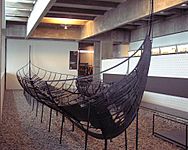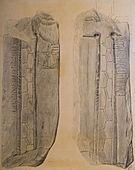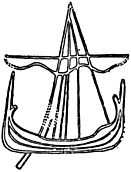Ímar mac Arailt facts for kids
Quick facts for kids Ímar mac Arailt |
|
|---|---|

Ímar's name it appears on folio 17r of Oxford Bodleian Library Rawlinson B 488 (the Annals of Tigernach): "h-Imar mac Arailt".
|
|
| King of Dublin | |
| Reign | 1038–1046 |
| Predecessor | Echmarcach mac Ragnaill |
| Successor | Echmarcach mac Ragnaill |
| Died | 1054 |
| House | Uí Ímair |
| Father | Aralt mac Amlaíb |
Ímar mac Arailt (died 1054) was an important ruler in the 11th century. He was a king of Dublin, a major city in Ireland, and possibly also ruled the Kingdom of the Isles, which included islands like the Isle of Man.
Ímar was the son of a man named Aralt. He was likely the grandson of Amlaíb Cuarán, a powerful king who ruled both Northumbria (in England) and Dublin. This family connection meant Ímar was part of the Uí Ímair, a famous Viking family. His uncle, Sitriuc mac Amlaíb, was also a King of Dublin, but he was forced out by Echmarcach mac Ragnaill in 1036.
Ímar became King of Dublin in 1038, taking the throne from Echmarcach. He ruled for at least eight years, until 1046, when Echmarcach took the kingship back. During his time as king, Ímar led military actions across Ireland. He also seemed to help the family of Iago ab Idwal ap Meurig, a king in Wales. Ímar died in 1054. Some historians believe he might have been an ancestor of Gofraid Crobán, another important king who ruled Dublin and the Isles later on.
Who Was Ímar's Family?
Ímar was probably the son of Aralt mac Amlaíb. Historical records from the 12th to 17th centuries mention Aralt's death in the Battle of Glenn Máma.
If this is true, then Ímar's grandfather on his father's side would have been Amlaíb Cuarán. This would also mean that Sitriuc mac Amlaíb, another King of Dublin, was Ímar's uncle.
The Fight for Dublin

Ímar's uncle, Sitriuc, ruled Dublin for nearly 50 years, from 989 to 1036. It's thought that his kingdom included the Isle of Man by the early 11th century.
Sitriuc's rule in Dublin ended when Echmarcach mac Ragnaill drove him out and became king himself. Before this, Sitriuc seemed to have a strong connection with Knútr Sveinnsson, a powerful king who ruled England, Denmark, and Norway. Knútr's power in the Irish Sea region likely helped Sitriuc keep his throne safe.
It's possible that Echmarcach couldn't act against Sitriuc while Knútr was alive. When Knútr died in 1035, it caused confusion, and Echmarcach might have used this chance to take control of the Irish Sea area. Sitriuc didn't seem to go to the Isle of Man after being kicked out of Dublin. This suggests that Echmarcach might have already controlled the island, perhaps even using it to plan his takeover of Dublin.

Echmarcach didn't rule Dublin for long. In 1038, old records show that Ímar replaced him as King of Dublin. This means Ímar likely forced Echmarcach out. Around this time, Þórfinnr Sigurðarson, a powerful earl from Orkney, was expanding his influence into the Isles and the Irish Sea. His actions might have played a part in Echmarcach losing Dublin in 1038.
It's possible that Ímar got some help from Haraldr Knútsson, Knútr's son and successor in Britain. Haraldr was king when Ímar took over from Echmarcach. Ímar's reign lasted about eight years. One of his first actions as king was invading Rathlin Island in the same year. The fact that he then campaigned in the North Channel might mean Echmarcach had power there before he took Mann and Dublin.
In 1044, records show that Ímar attacked the area of the Uí Fhíachrach Arda Sratha and killed their leader. He also attacked the church of Armagh and burned the Scrín Pátraic (the "Shrine of Patrick"). This shrine was a special decorated box that held parts of a saint's body or items linked to them. The "Shrine of Patrick" likely held parts of St Patrick himself.
The next year, Ímar invaded Rathlin Island again. He killed 300 noblemen from the Ulaid people, including a young leader named Ragnall Ua Eochada. This big event might mean that Dublin and the Ulaid were fighting for control of Rathlin Island. If so, it could suggest that Ímar controlled the Isle of Man by then. The Ulaid's land is the closest Irish territory to Mann. Controlling the Manx fleet (ships) would explain how Dublin could challenge the Ulaid. After this, Niall mac Eochada, the King of Ulaid, attacked Fine Gall, Dublin's rich farmland to the north. This was probably a revenge attack.
The next year, in 1046, Echmarcach took over from Ímar again. Records say that Ímar was forced out, and the people of Dublin chose Echmarcach as their king. After this, all we know for sure is that Ímar died in 1054.
However, some sources call Ímar rí Gall ("king of the foreigners"). This might mean that when Diarmait mac Maíl na mBó, the King of Leinster, drove Echmarcach from Dublin in 1052, Diarmait put Ímar back on the throne.
After Ímar's death, Diarmait seems to have given control of Dublin to his own son, Murchad mac Diarmata, around 1059. In 1061, Murchad invaded the Isle of Man and seems to have defeated Echmarcach. This could mean Echmarcach had settled on the island after being driven from Dublin. Or, he might have become king of the Isles again after Ímar died in 1054. Both Diarmait and Murchad died by 1072. Diarmait was called "King of the Isles" when he died, which suggests that by the 11th century, controlling the Isle of Man was key to being King of the Isles.
Ímar's Role in Wales
| A simplified family tree showing the connection between Ímar and Cynan ab Iago, who was likely his ally. Women's names are in italics. | ||||||||||||||||||||||||||||||||||||||||||||||||||||||||||||||||||||||||||||||||||||||||||||||||||||||||||||||||||||||||||||||||||||||||||||||||||||||||||||||||||||||||||||||||||||||||||||
|---|---|---|---|---|---|---|---|---|---|---|---|---|---|---|---|---|---|---|---|---|---|---|---|---|---|---|---|---|---|---|---|---|---|---|---|---|---|---|---|---|---|---|---|---|---|---|---|---|---|---|---|---|---|---|---|---|---|---|---|---|---|---|---|---|---|---|---|---|---|---|---|---|---|---|---|---|---|---|---|---|---|---|---|---|---|---|---|---|---|---|---|---|---|---|---|---|---|---|---|---|---|---|---|---|---|---|---|---|---|---|---|---|---|---|---|---|---|---|---|---|---|---|---|---|---|---|---|---|---|---|---|---|---|---|---|---|---|---|---|---|---|---|---|---|---|---|---|---|---|---|---|---|---|---|---|---|---|---|---|---|---|---|---|---|---|---|---|---|---|---|---|---|---|---|---|---|---|---|---|---|---|---|---|---|---|---|---|---|
|
||||||||||||||||||||||||||||||||||||||||||||||||||||||||||||||||||||||||||||||||||||||||||||||||||||||||||||||||||||||||||||||||||||||||||||||||||||||||||||||||||||||||||||||||||||||||||||
During Ímar's reign, the main Welsh king was Gruffudd ap Llywelyn. One of Gruffudd's rivals was Iago ab Idwal ap Meurig, who had killed Gruffudd's father in 1023. Iago then ruled Gwynedd until his own death in 1039. Gruffudd himself might have been responsible for Iago's death and became King of Gwynedd afterward.
Because of Iago's fall and the change in power, Iago's son, Cynan ab Iago, fled overseas and found safety in Dublin.
According to an old text called Historia Gruffud vab Kenan, Cynan's son, Gruffudd ap Cynan, had a mother named Ragnailt ingen Amlaíb. She was the granddaughter of Sitriuc. This text also says that Ragnailt's father, Amlaíb mac Sitriuc, built and commanded a Welsh fort called Castell Avloed. We don't know how long the Dubliners held this fort. In 1036, another son of Sitriuc was killed in Wales by a relative. This could mean there was a fight for control of the fort. Echmarcach's expulsion of Sitriuc from Dublin in the same year might mean Sitriuc sought safety in Wales.
Even though we don't know exactly where Castell Avloed was, it seems to have been in an area Iago used to control. It's likely that after Iago's defeat and Cynan's escape, Ímar led military actions against Gruffudd. For example, three years later, old Welsh texts report that Gruffudd was captured by forces from Dublin. Later accounts say that Gruffudd was captured because the Dubliners were helping Cynan. These stories also say that Gruffudd managed to escape when Welsh forces attacked the Dubliners before they could return to Ireland. The fact that Cynan worked with the Dubliners against Gruffudd suggests that Ímar was personally involved as king, and that the Welsh fort of Castell Avloed was still controlled by the Dubliners.

Another conflict that might have involved Ímar and Dublin's military was Gruffudd's final defeat of Hywel ab Edwin, the King of Deheubarth. This battle happened near the mouth of the River Tywi and included Vikings from Ireland who supported Hywel. It seems that Gruffudd's enemies often got military help from the Viking settlements in Ireland. An old text from the 12th century says that Gruffudd fought against English, Irish, and Vikings during his career.
Ímar's Legacy
Ímar might have been the father, uncle, or even the brother of Gofraid Crobán, who later became King of Dublin and the Isles. In 1091, an old record states that Gofraid was King of Dublin and calls him "... mac Maic Arailt" (son of the son of Aralt). Another old text, the Chronicle of Mann, says Gofraid's father was from "Ysland". This could mean Iceland, Islay, or Ireland. There's no other evidence connecting Gofraid to Iceland. The chronicle also says Gofraid died on Islay. If "Ysland" means Ireland, the spelling might be from an English or French source.
In the records of his military actions in 1044, Ímar is simply called the son of Aralt. This might be how people knew him back then. If so, the name given in the Chronicle of Mann might just be a slightly changed version of this.











